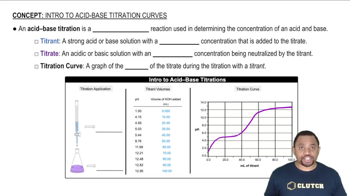What kind of reaction is this? N2(g)+3H2(g)⟶2NH3(g)
a. an acid–base reaction
b. a metathesis reaction
c. a redox reaction
d. a precipitation reaction
 Verified step by step guidance
Verified step by step guidance



What kind of reaction is this? N2(g)+3H2(g)⟶2NH3(g)
a. an acid–base reaction
b. a metathesis reaction
c. a redox reaction
d. a precipitation reaction
An aqueous solution contains 1.2 mM of total ions. (a) If the solution is NaCl(aq), what is the concentration of chloride ion?
An aqueous solution contains 1.2 mM of total ions. (b) If the solution is FeCl3(aq), what is the concentration of chloride ion?
State whether each of the following statements is true or false. Justify your answer in each case. (a) Electrolyte solutions conduct electricity because electrons are moving through the solution.
State whether each of the following statements is true or false. Justify your answer in each case. (b) If you add a nonelectrolyte to an aqueous solution that already contains an electrolyte, the electrical conductivity will not change.
We have learned in this chapter that many ionic solids dissolve in water as strong electrolytes; that is, as separated ions in solution. Which statement is most correct about this process? (a) Water is a strong acid and therefore is good at dissolving ionic solids. (b) Water is good at solvating ions because the hydrogen and oxygen atoms in water molecules bear partial charges. (c) The hydrogen and oxygen bonds of water are easily broken by ionic solids.